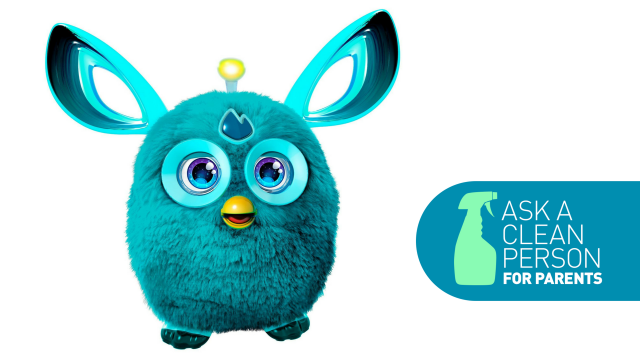Jolie Kerr is a cleaning expert, advice columnist and author of the New York Times bestselling book, My Boyfriend Barfed In My Handbag … And Other Things You Can’t Ask Martha. Her flagship column, “Ask a Clean Person”, debuted in 2011. Here on Lifehacker, we’re launching a new iteration of it, focusing on parenting and all the messes it brings.
Photo via Hasbro
After last week’s column on cleaning plush toys, a bunch of you had follow up questions about cleaning hard plastic toys – such as dolls, or LEGO – and toys that cannot be submerged because they have electronic or audio components to them. So I figured I’d do a follow-up of sorts to address those questions! Let’s get right into it.
Hard Plastic Toys
There are a few ways to approach cleaning hard plastic toys, with some pros and cons attendant to each method.
Wash ‘Em Like Dishes
Plastic toys can go into the dishwasher, or be washed by hand just like you would a dish, using hot, soapy water and a sponge or dish cleaning cloth.
If you use the dishwasher, be sure to put the toys on the top rack. The heating element of most dishwashers is on the bottom of the unit, so using the top rack will help to prevent heat damage. A dishwasher safe basket or mesh washing bag can corral small toys such as LEGO bricks, toy soldiers and Hot Wheels cars that might otherwise slip through the dishwasher’s racks.
One caveat, however, is that many dishwashing detergents can have a slight bleaching effect, and some toys are not colourfast, which could lead to damage in the form of fugitive dye or colour loss.
Wash ‘Em Like Clothes
Just as with plush toys, many hard toys can go into the washing machine. This is a less ideal way than the dishwashing approach, as the agitation of the washer is more likely to cause damage, but it’s still worth throwing out there as an option. The use of mesh wash bags can help to keep, say, a Barbie’s hair from getting tangled, and padding the drum with towels will help to prevent damage and/or a huge racket.
Wash ‘Em Like a Baby’s Tush
Baby wipes are GREAT for quickly wiping off toys that have gotten grimy, sticky and germy. Baby wipes aren’t antibacterial, so they won’t nuke viruses, but in a pinch they can certainly be pressed into use for wiping away drool, food and even vomit.
Toys with Electronic or Musical/Voice Box Components
Toys that have voice or music boxes in them, or that light up or otherwise move, pose a cleaning challenge in that they cannot be submerged in water.
Before I get into the instructions on how to clean stains, dirt and grime off of toys that have electrical components, it’s important to note, annoyingly enough, that routinely cleaning these types of playthings is pretty crucial. Ugh, I knowwwww. It makes me feel whiny just thinking about it, but I have to be honest with you guys, even when it means delivering news that makes me want to go prone on my floor and beat my fists against the hardwood.
The reason for this is that if you let a toy that cannot be submerged in water and detergent go too long without cleaning, the buildup of grime and suchlike will become so totally one with the toy that you may not be able to get it fully clean.
For Grime
With that bad news out of the way, let’s turn to the good news, which is this: It’s very simple to clean these kinds of toys and the whole operation shouldn’t take you more than five minutes. Here are the steps you’ll take:
- Start by removing the batteries and, if the toy’s design allows for it, the entire battery pack;
- Fill a small bowl halfway up with warm water, and a very, very, very tiny amount of liquid or powdered laundry detergent, dishwashing liquid, Dr Bronner’s and so on. When I say tiny amount I really do mean, like, a quarter teaspoon. If you use more than that there will be detergent residue left on the toy, and that’s not what we’re going for here. So be sparing! You can always introduce more detergent if it’s needed;
- Dip a light-coloured rag, such as a washcloth, dishrag or cut up T-shirt, into the solution, and wring it out so that it is damp but not dripping;
- Give the toy a gentle scrubbing, reapplying the detergent solution to the rag as needed;
- Once the toy is clean, repeat that process with clean water to remove the suds;
- Wrap in a towel to absorb moisture, then allow to air dry;
- If the toy looks a little matted after cleaning, use a hairdryer on cool or low heat at the very end of the air drying process to fluff it back up.
For Smells Only
Sometimes these types of toys have taken on an odour, or one lingers even after cleaning. No sweat, here are two ways to eliminate smells without using liquid cleaners.
- Bury the toy in clean kitty litter or loose active charcoal (the latter can be found at aquarium supply stores) for 12-48 hours. After the burial, go ahead and give the toy a quick cleaning using the method above to remove residue from the litter or charcoal.
- Bury the toy in or sprinkle it with a liberal amount of bicarbonate of soda. Allow the bicarbonate of soda to absorb smells for 12-48 hours, then shake off or vacuum up the bicarbonate of soda.
Do you have a super genius method for cleaning toys? Please share it in the comments!

Comments